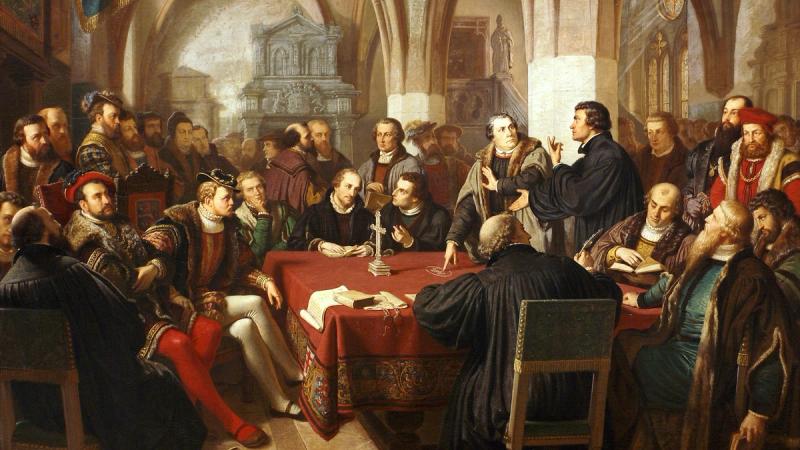At the 1529 Colloquy of Marburg, Martin Luther and Ulrich Zwingli famously engaged in a heated theological debate surrounding the presence of Christ in the Lord’s Supper, leading to Luther endlessly repeating the phrase “Hoc est corpus meum” (this is my body) as definitive proof of the identification between Christ’s incarnate body and that which is orally received by the communicant. This event led to Luther refusing to shake the other reformer’s hand over these doctrinal disagreements, and thus signified the ideological divide which would split these two reform movements from one another. One may attribute such an act on Luther’s part as that of theological stubbornness over the exegetical conclusions of one small set of texts. The concern for Luther (and for the Lutheran tradition as a whole), however, goes far beyond a difference of interpretation of the words of institution. The chief area of disagreement was instead located within the central Christian doctrine of the incarnation; the debate surrounding the Eucharist exemplified this more basic underlying difference.[1]
The Finite is Capable of the Infinite
The Christological debate is best summarized by a theological axiom often repeated by Zwingli that the finite is not capable of the infinite (finitum non capax infiniti). For Luther, the incarnation itself would be negated by Zwingli’s statement, as in Paul’s words, the “fullness of the [infinite] Godhead” dwells within the human nature of Christ (Col. 2:9). A robustly Christian and incarnational theology demands a union between infinite and finite, however little the human mind is able to grasp such a union. Certainly, Zwingli contended that he retained a consistent belief in the Chalcedonian definition of the hypostatic union, not consciously attempting to revive the Nestorian heresy by dividing the two natures into a dual personhood. Nonetheless, this is what Lutherans continue to argue that Zwingli’s principle—if carried out consistently—leads to.[2]
The specific area in which Zwingli’s principle was operative was with regard to the communion between the divine and human natures of Christ within the theanthropic person. For Luther, the fact that Christ’s body is present at every church altar in the service of the Sacrament necessitates that his body is not limited in its locality as are ordinary human bodies. Through the hypostatic union, divine attributes are operative in and through the humanity of Christ, resulting in the overcoming of spatial limitations. Zwingli, in opposition to this, purported that Christ’s humanity did not—indeed could not—receive any communication of attributes from the divine nature, as this would result in that which is infinite being communicated to something finite, which is a logical impossibility.
Along with these differences were two divergent manners of understanding Christ’s ascension. For Zwingli, Christ’s ascension implies the actual departure of Christ’s human nature from the earth (in every possible sense). His earthly presence is solely that of the divine nature through his Spirit, while Christ’s humanity is limited in its location to the right hand of his Father in heaven. While it is Luther who is often accused of being overly literalist in his reading of the Scriptural text, it was Zwingli who understood Christ’s being seated at the Father’s right hand as a literal spatial statement. Luther, in contrast to this, understood that such phrases reference Christ’s role of authority due to his exaltation, thus including a divine authority communicated to the human nature. One need not understand the “right hand” as an actual place. Furthermore, this demonstrates a fundamental difference between Zwingli and Luther’s understanding of space. For Zwingli, heaven is a location which is elsewhere than the physical realm. For Luther, however, heaven is coextensive with physical creation, as an underlying invisible reality which overlaps with the physical. Like Plato’s forms, this unseen realm is continually intertwined with the realities of daily life on the earth. The culmination of such a heaven and earth union is in the Eucharistic giving of the incarnate eternal Son at the altar.
The Incarnation Saves
For the Lutheran tradition, the incarnation is not only the necessary beginning of a life of federal representation of Christ on behalf of his people. Beyond that, there is a salvific reality to be found within the act of incarnation itself. The hypostatic union is the culminating event of God’s immanent relationship with the created world. It is here in the womb of the Virgin Mary that the infinite and uncreated Son is united to the finite created nature of humanity. The union of the infinite and finite is the very purpose of the incarnation. In view of this, one can understand precisely why this question was so fundamental to Luther, as it touches upon the central redemptive realities of the Christian faith.
This strong incarnational theology is at the core of the Lutheran understanding of the means of grace. The infinite God has bound himself to these finite means of grace: human words, water, bread and wine. While the Reformed tradition developed its own understanding of the means of grace, it has continued to reject the strict tie between the sacraments and the operative work of the Holy Spirit as taught by Luther. This is a corollary to the Calvinistic doctrine of predestination, wherein saving grace is imparted only to the elect, which one must reconcile with the fact that the category of the baptized is far broader than that of the eschatologically glorified saints. Thus, for the Reformed tradition, the act of regeneration is a spontaneous action of the Holy Spirit.[3] While God often uses the means of grace to accomplish this, they are not strictly bound together.[4] For Luther, however, God has bound himself to both word and sacrament to such an extent that God’s own presence and work always accompanies the administration of the sacraments and the proclamation of the divine word.
Consider the debate between later Calvinists and Lutherans over the question of the manducatio indignorum (the eating of the ungodly). While Reformed theologians contended that the Eucharistic meal involves a spiritual partaking of Christ by faith, they rejected the Lutheran insistence that the true body of Christ is received universally by all communicants, regardless of their individual state of faith. For Lutheran theologians, this contention severs the tie between God and his means of grace, locating the sacramental benefit in the subjective posture of the recipient, rather than the objective and universal promise of God as located in the physical means. This difference is, ultimately, rooted in the incarnation itself. Finnish Lutheran theologian Tuomo Mannermaa speaks of a collective personhood accomplished in the act of incarnation, whereby the eternal Son accomplish a unification between God and humanity as a whole in his own person, bringing the accomplishment of redemption into the same scope as the sin brought about by the first Adam (Rom. 5).[5] This universality implied in the incarnation is then the backdrop for the universality of God’s unification with the means of grace for the benefit of human salvation. The particularity of the covenant of redemption and its outworking in the Reformed system simply does not allow for this. Thus, the debates about Christ’s incarnation that Luther and Zwingli engaged in extends beyond the Supper to the theology of the means of grace, and salvation as a whole.
This divergence is also apparent in the reception of the language of theosis within the devotional literature of the Lutheran church, where it is not consistently present among Reformed theologians.[6] If Zwingli’s principle of the nature of finitude and infinitude is correct, then there can be no sharing of divine properties from the divine to the human natures in Christ. With this being the case, there certainly can be no participation in divinity for those who are in Christ, and thus no theosis. Mystical writers who spoke boldly about divinization had a strong impact on the development of Luther’s thought, while Calvin referred to Luther’s favored mystical text, the Theologia Germanica, as “poison.”[7] This Lutheran contention that the Christian shares in the divine nature was Christologically rooted, being a reiteration of Cyril of Alexandria’s Christological writings.[8] For Cyril, Christ’s life includes a gradual deification of the human nature, which is then paradigmatic for the believer’s sharing in the divine life. Such a participation is possible without a collapse of the human nature into the divine, as the finite indeed can share in the infinite without an absorption of the created into the uncreated. This sharing in the divine life, for Lutheran theologians, culminates in the Lord’s Supper.[9]
Conclusion
While the Lutheran and Reformed traditions have several areas of agreement which are to be celebrated, such as their mutual insistence on justification through faith alone, the supreme authority of Scripture, and the sufficiency of divine grace in human salvation, significant differences remain. The root of these differences is exactly where Luther himself found it, not just in the words of institution, but within a more basic Christological division. For Zwingli and the later Reformed tradition, the infinite nature of divinity is distanced from finite creation. For Luther, the finite created order is capable of sharing in the infinite. This has implications for Christology, sacramental theology, and the believer’s participation in the divine life.
Jordan Cooper is the executive director of Just and Sinner, the host of the weekly Just and Sinner Podcast, and an adjunct professor of Systematic Theology at the American Lutheran Theological Seminary. He is also the founder of the Weidner Institute, which hosts both online courses and seminars for continuing theological education for both clergy and laity. He has authored several books, including his most recent Prolegomena: A Defense of the Scholastic Method.
[1] For the history and theology behind this occurrence, see Hermann Sasse, This is My Body: Luther’s Contention for the Real Presence in the Sacrament of the Altar.
[2] See Francis Pieper’s argument in his Christian Dogmatics, II:243.
[3] Charles Hodge, Systematic Theology, III:31-32.
[4] This is clear, for example in chapter 28.6 of the Westminster Confession of Faith.
[5] Tuomo Mannermaa, Christ Present in Faith: Luther’s View of Justification, ed. and trans. by Kirsi Irmeli Stjerna, 15.
[6] Such a teaching is apparent in Gerhard’s Sacred Meditations and Johann Arndt’s True Christianity among other works.
[7] Cited in The Theologia Germanica of Martin Luther, trans. by Bengt Hoffman, 26.
[8] Saint Cyril of Alexandria, Against Those Who are Unwilling to Confess that the Holy Virgin is Theotokos trans. by George Dion.
[9] Gerhard writes: “This most divine feast will make us divine men, until we at long lost are made partakers of the future blessedness…and complete participants in the divine nature.” Gerhard, Johann. Sacred Meditations, trans. by Wade R. Johnston (Saginaw, MI: Magdeberg, 2011), 88.




